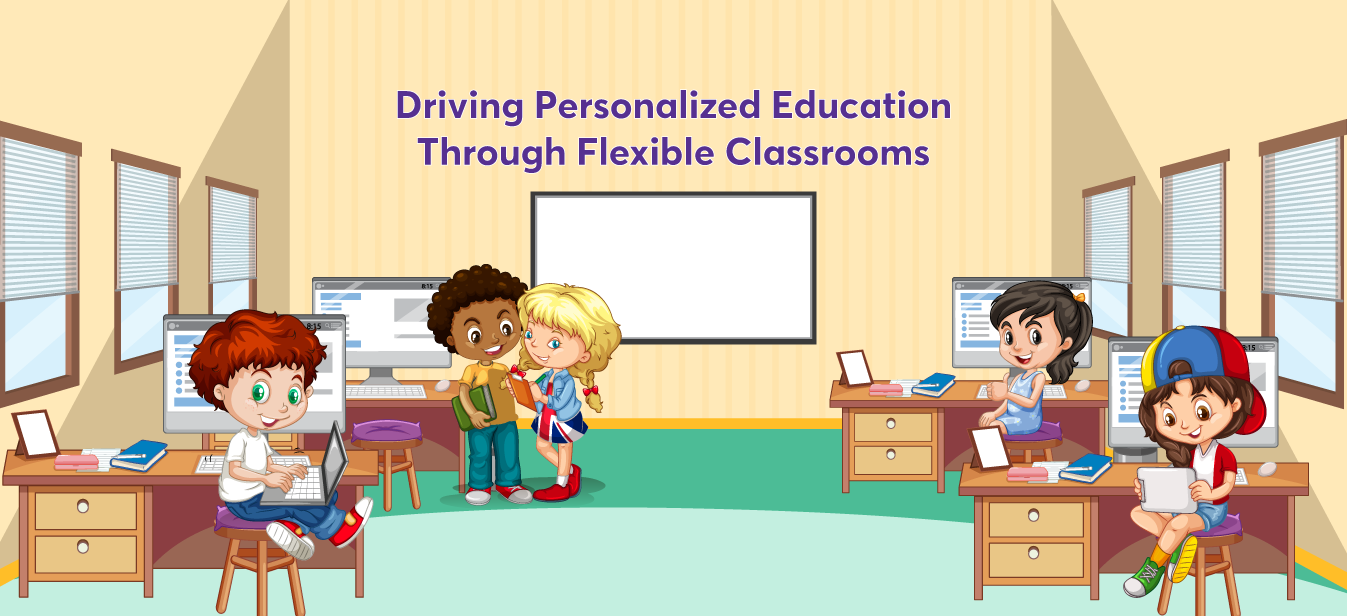You might not think it, but room arrangements can actually make a big difference on a student’s performance. As a learning environment, it’s not too surprising that flexibility impacts success by putting the student at the center. Flexible room layouts allow for a more student-centric teaching and learning methodology. In fact, flexibility can be a driver for increased engagement and performance in students, teachers and the school as a whole.
Let’s understand what flexible classrooms are
Flexible classrooms are an innovative idea that strikes a balance between the two dominant educational paradigms: traditional classrooms (with rows of desks), and project-based problem-oriented learning. Each flexible room has its own unique set of features. Children and teachers adjust them to suit the activities they choose to complete while in those spaces. Because no two flexible-space classrooms are alike, and children who study in them may be from different grades, each flexible-space classroom presents unique challenges for those working in them.
Flexible learning spaces are not one-size-fits-all, nor are they static. There is no one right way to set up a flexible classroom; every teacher should decide what works best for them and their students. Below are some of its features:
✏️ Movable Furniture
A flexible classroom allows for the movement of furniture, creating a variety of seating arrangements to best suit a variety of different classroom activities, such as lectures, small group discussions, and lab exercises. The classroom arrangement depends on the curriculum and purpose for which it is being used. In addition, furniture should be comfortable, durable and sized appropriately for students.
Flexible classrooms are designed to give students choices about where they work and how they learn. For example, if a student wants to collaborate with other students on a project, they can move desks into a circle so that all members can be involved in the discussion. If another student needs space from others or wants time alone to concentrate on an assignment, they can choose a quiet corner or workstation away from the group activity.
✏️ Storage Spaces
A flexible classroom has shelves or storage bins for each child’s belongings to avoid clutter around the room. There also might be a little kitchen area where children can make snacks and keep their lunch readily available.
✏️ Technology Integration
The current generation of learners have grown up with technology. They expect it to be part of their learning experience. They live in an interactive world where mobile technology allows them to connect with others continually, access information quickly, and multitask daily. It’s also essential to have technology available to support a flexible classroom layout, where students have the freedom to decide how they organize their time, space, tools and activities.
The technology used in the classroom takes many forms, including interactive whiteboards, projectors, document cameras, computers, and digital recorders. Technology will enable teachers to present content in numerous ways and engage students in hands-on learning activities.
✏️ Display Areas
Display areas also provide opportunities to revisit past lessons and concepts. Children’s work is displayed throughout the room to showcase student effort and encourage peer review.
✏️ Supportive Materials
Flexible classrooms contain various instructional materials that support multiple learning styles and interests. Materials may include elements such as blocks or number tiles, audiovisual aids such as videos and games, science kits, art supplies, maps, musical instruments, dress-up clothes, and dramatic play props such as puppets or play money, sports equipment, etc.
It’s important for teachers not just to allow flexibility, but also make use of it themselves. While some instruction will happen at the front of the room, for example, during whole-class discussions, teachers may occasionally move around the classroom while teaching and checking student progress.
The Bottom Line
Formal learning spaces are becoming more flexible and informal, creating a blend of work and lifestyle. While traditional classrooms are the most used learning spaces, they do not offer all the elements desired in a flexible learning space. A study has shown that flexible classrooms provide increased collaboration, more engaging material delivery mechanisms, close proximity between students, and teacher workstations that are not separate from students. Flexible classrooms can help create the right environment for learning for students and educators, and it is something that teachers and institutions everywhere need to closely consider when setting up their classrooms, for it can create a joyful learning environment.
Inclusive classrooms will be the norm in the near future. Educational institutions are already taking steps toward more-flexible spaces for students of all learning styles. Our programs are designed considering the differences in students’ learning styles and how teachers can be flexible in their approach to stay relevant and in tune with the needs of each student. To know more, visit, ecce.squarepanda.in.



























